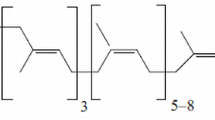Summary
When young male rats were fed on a diet containing 50 cal.-per cent of soybean oil or rapeseed oil, carrier-free radio-iodine,131I, injected intraperitoneally in doses of 5.5–6.5 μc per animal, accumulated in the thyroid glands of therapeseed oil group at a slower rate and in smaller amounts than in the control group fed on soybean oil. The radioactivity of the glands of the rapeseed oil group remained approximately constant between 12 and 24 hours after the injection, whereas the activity of the glands of the control group continued to increase up to a maximum at about 24 hours.
The rate of depletion of the thyroidal radio-iodine was greater in the rapeseed oil group than in the soybean oil group. The biological half-life of131I was found to be 4.6 days in the rapeseed oil group and 5.4 days in the soybean oil group, when calculated relative to the radioactivity of the thyroid 48 hours after the injection.
When the rapeseed oil diet was replaced by the corresponding saponifiable fraction plus glycerol or by adding the unsaponifiable fraction of rapeseed oil to soybean oil, the biological half-life of131I was found to be 6.0 dyas in the former and 4.4 days in the latter. Thus the unsaponifiable fraction of rapeseed oil reduced the half-life in animals fed on soybean oil to the same level as that in animals fed on rapeseed oil. The effect of this same fraction on the iodine uptake curve of the soybean oil group was also to modify it so that it resembled the uptake curve of the rapeseed oil group.
The results obtained indicate that rapeseed oil, and specifically its unsaponifiable fraction, contain a factor (or factors) which interferes with the ability of the thyroid gland to accumulate iodine from the plasma, but which does not seem to prevent the binding of iodine in organic form. For this reason, the thyroid gland itself becomes deficient in iodine, with the consequence that the synthesis of thyroxine is reduced and the secretion of thyrotrophic hormone increased. The result is hypothyroidism, despite the presence of an adequate amount of iodine in the diet.
Similar content being viewed by others
References
Astwood, E. B., Greer, M. A. andEttlinger, M. G., J. Biol. Chem.181, 121 (1949).
von Beznak, A., von Beznak, M. andHadju, M., Ernährung8, 236 (1944). Ref.: Chem. Abstr.39, 2544 (1944).
Carroll, K. K., Endocrinol.48, 101 (1951).
Carroll, K. K. andNoble, R. L., Endocrinol.51, 476 (1952).
Carroll, K. K. andNoble, R. L., Can. J. Biochem. Physiol.35, 1093 (1957).
Deuel, H. J., Jr.,Greenberg, S. M., Staub, E. E., Jue, D., Gooding, C. M. andBrown, C. F., J. Nutrition35, 301 (1948).
Deuel, H. J., Jr.,Hallman, L. andLeonard, A., J. Nutrition20, 215 (1940).
Lips, H. J., Can. J. Technol.39, 61 (1952). Ref.: Biol. Abstr.27, 3490 (1953).
Greer, M. A., Physiol. Rev.30, 513 (1950).
Official Methods of Analysis of the Association of Official Agricultural Chemists1950, 441.
Roine, P. andUksila, E., Acta Agr. Fenniae94, 11 (1959).
Taurog, A. andChaikoff, I. L., J. Biol. Chem.169, 49 (1947).
Taurog, A. andChaikoff, I. L., J. Biol. Chem.176, 639 (1948).
Taurog, A., Chaikoff, I. L. andFeller, D. D., J. Biol. Chem.171, 189 (1947).
Taurog, A., Chaikoff, I. L. andTong, W., J. Biol. Chem.184, 99 (1950).
Taurog, A., Tong, W. andChaikoff, I. L., J. Biol. Chem.191, 677 (1951).
Thomasson, H. J., J. Nutrition56, 455 (1955).
Thomasson, H. J., J. Nutrition59, 343 (1956).
Turner, C. W., Poultry Sci.27, 118 (1948).
Wolff, J., Endocrinol.48, 284 (1951).
Wolff, J., Chaikoff, I. L., Taurog, A. andRubin, L., Endocrinol.39, 140 (1946).
Vanderlaan, J. E. andVanderlaan, W. P., Endocrinol40, 403 (1947).
Author information
Authors and Affiliations
Rights and permissions
About this article
Cite this article
Niemi, U.M., Roine, P. The effect of rapeseed oil on the thyroid function of rats. Z Ernährungswiss 1, 164–170 (1960). https://doi.org/10.1007/BF02019791
Received:
Published:
Issue Date:
DOI: https://doi.org/10.1007/BF02019791




